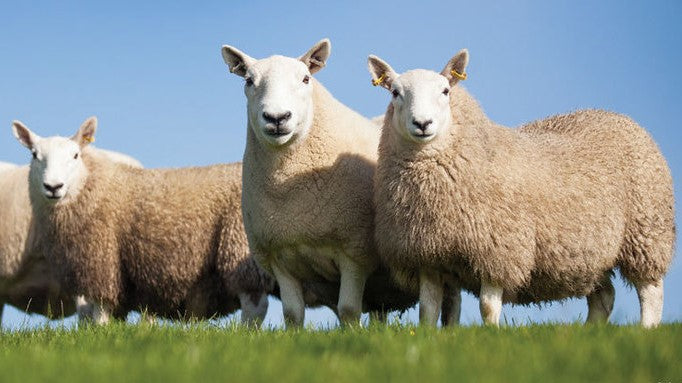Cheviot Sheep History:
The Cheviot sheep get their name from the Cheviot Hills, located in English Northumberland and the Scottish Borders. The Cheviot sheep breed are known for their beautiful white wool and distinctive wool-free faces. From straight-on the faces can easily be mistaken for a bunny rabbits!
These sheep are one of the few well-recognized breeds in England, having been recorded on the borderlands as early as the 14th century. According to the legend, the breed developed from sheep that swam to safety after a Spanish ship sunk off the coast of the Cheviot Hills. They are commonly referred to as “Border Sheep” for this very reason. Their wool became popular for Border Tweed, made strictly of Cheviot due to it’s resilience and DNA-type crimp structure which makes for greater fiber durability.
There are 4 main subgroups of Cheviot Sheep, but all are known for their white wools and clean faces & legs. Cheviots are great producers of wool because they have quality fleeces into their teens, which is astounding considering the average life expectancy of sheep across all breeds is just 12 years.
What are Cheviot Sheep Known For?
Interestingly, Cheviot sheep are most known for the crimp of their wool fibers. What is crimp you might ask? All sheep breeds have a certain amount of crimp to their wool coats, which is simply the way in which their fibers grow, similar to your human hair. Wool fibers grow and intertwine in a wavy, twisting pattern in sheep breeds. It is the amount of twist that affects the variability of the crimp, and durability of the wool. The crimp itself is designated by how Keratin (a key element in the structure of wool) connects. Keratin can grow in 2 common ways (folded chain & helical spiral) patterns.
The Cheviot’s helical crimp makes it’s wool incredibly durable and keeps the structural integrity as the surfaces bend and shift to prevent wear. Think bridge cable rather than iron rod. Both are strong in their owns ways, but the cable allows for shifting and movement without breaking under pressure. Much like a cable, the helical crimp helps make the wool fibers springy and strong to withstand pressure and wear.
The Cheviot fleece varies in quality from fine to coarse and has many applications, making this wool very versatile. It is a good, white colour overall. It is not too crimpy and is quite resilient, which makes Cheviot wool suitable for filling purposes. The fineness is approx. 30-33 microns and length, 80-100mm. Perfect for hand spinning, hand felting and many other craft uses.
What Makes Cheviot Wool So Popular?
While not as soft or luxurious as it’s sister breeds Corriedale and Meirno, Cheviot makes very durable finished products. Felters commonly use Cheviot as an alternate white to Corriedale for large felting projects or as base to build upon for needle and wet felting alike. It’s also great for beginner and advanced spinning (both on a wheel and drop spindle) and once it’s spun into yarn it is commonly used for outwear and household items that receive a lot of use. Some of the most popular uses include sweaters, socks, beanies, blankets, pillow and as a core natural white wool for tapestry art and wall hangings.
The fibers have a great draft, particularly when combed, that make it a popular wool for all hand spinners. If you are planning to ply keep in mind that it can be loftier than you might anticipate. Chevit wool is resistant to both snow and rain. Their fleece allows them to stay more comfortable and protected year round
Popular Project Uses
- Wall Hangings
- Spinnning to yarn
- Knitting for outterwear and household items
- Tapestry art
How to Care For Your Cheviot Projects:
- Machine washable – Cheviot is easily washable up to 40 degrees Celsius so it can be washed with all your other clothing and regular detergent can be applied.
Try our beautiful, all-natural Cheviot wool roving today and let us know what you think!
Looking for a different wool breed? See our natural, cruelty free selection here!



